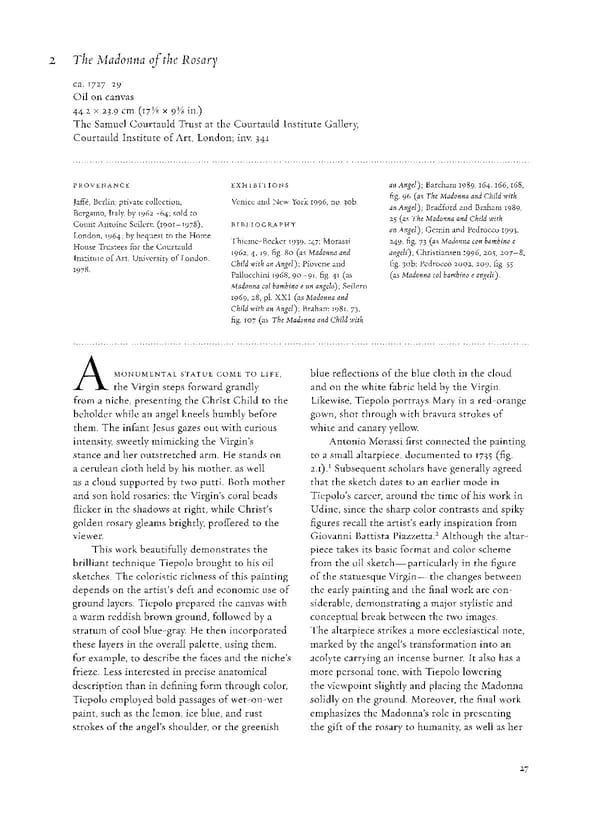2 The Madonna of the Rosary ca. 1727-29 Oil on canvas 3 3 44.2 x 23.9 cm (i7 /s x 9 /s in.) The Samuel Courtauld Trust at the Courtauld Institute Gallery, Courtauld Institute of Art, London; inv. 341 PROVENANCE EXHIBITIONS an Angel); Barcham 1989,164,166,168, Jaffe, Berlin; private collection, Venice and New York 1996, no. 3ob. fig. 96 (as The Madonna and Child with Bergamo, Italy, by 1962-64; sold to an Angel); Bradford and Braham 1989, 2$ (as The Madonna and Child with Count Antoine Seilern (1901-1978), BIBLIOGRAPHY an Angel); Gemin and Pedrocco 1993, London, 1964; by bequest to the Home Thieme-Becker 1939, 147; Morassi 249, fig. 73 (as Madonna con bambino e House Trustees for the Courtauld 1962, 4, 19, fig. 80 (as Madonna and angeli); Christiansen 1996, 205, 207-8, Institute of Art, University of London, Child with an Angel); Piovene and fig. 3ob; Pedrocco 2002, 209, fig. 55 1978. Pallucchini 1968, 90-91, fig. 41 (as (as Madonna col bambino e angeli). Madonna col bambino e un angelo); Seilern 1969, 28, pi. XXI (as Madonna and Child with an Angel); Braham 1981, 73, fig. 107 (as The Madonna and Child with AMONUMENTAL STATUE COME TO LIFE, blue reflections of the blue cloth in the cloud the Virgin steps forward grandly and on the white fabric held by the Virgin. from a niche, presenting the Christ Child to the Likewise, Tiepolo portrays Mary in a red-orange beholder while an angel kneels humbly before gown, shot through with bravura strokes of them. The infant Jesus gazes out with curious white and canary yellow. intensity sweetly mimicking the Virgin's Antonio Morassi first connected the painting stance and her outstretched arm. He stands on to a small altarpiece, documented to 1735 (fig. a cerulean cloth held by his mother, as well 2.x).1 Subsequent scholars have generally agreed as a cloud supported by two putti. Both mother that the sketch dates to an earlier mode in and son hold rosaries: the Virgin's coral beads Tiepolo's career, around the time of his work in flicker in the shadows at right, while Christ's Udine, since the sharp color contrasts and spiky golden rosary gleams brightly proffered to the figures recall the artist's early inspiration from viewer. 2 Giovanni Battista Piazzetta. Although the altar- This work beautifully demonstrates the piece takes its basic format and color scheme brilliant technique Tiepolo brought to his oil from the oil sketch—particularly in the figure sketches. The coloristic richness of this painting of the statuesque Virgin—the changes between depends on the artist's deft and economic use of the early painting and the final work are con- ground layers. Tiepolo prepared the canvas with siderable, demonstrating a major stylistic and a warm reddish brown ground, followed by a conceptual break between the two images. stratum of cool blue-gray. He then incorporated The altarpiece strikes a more ecclesiastical note, these layers in the overall palette, using them, marked by the angel's transformation into an for example, to describe the faces and the niche's acolyte carrying an incense burner. It also has a frieze. Less interested in precise anatomical more personal tone, with Tiepolo lowering description than in defining form through color, the viewpoint slightly and placing the Madonna Tiepolo employed bold passages of wet-on-wet solidly on the ground. Moreover, the final work paint, such as the lemon, ice blue, and rust emphasizes the Madonna's role in presenting strokes of the angel's shoulder, or the greenish the gift of the rosary to humanity, as well as her 27
 Giambattista Tiepolo: Fifteen Oil Sketches Page 27 Page 29
Giambattista Tiepolo: Fifteen Oil Sketches Page 27 Page 29